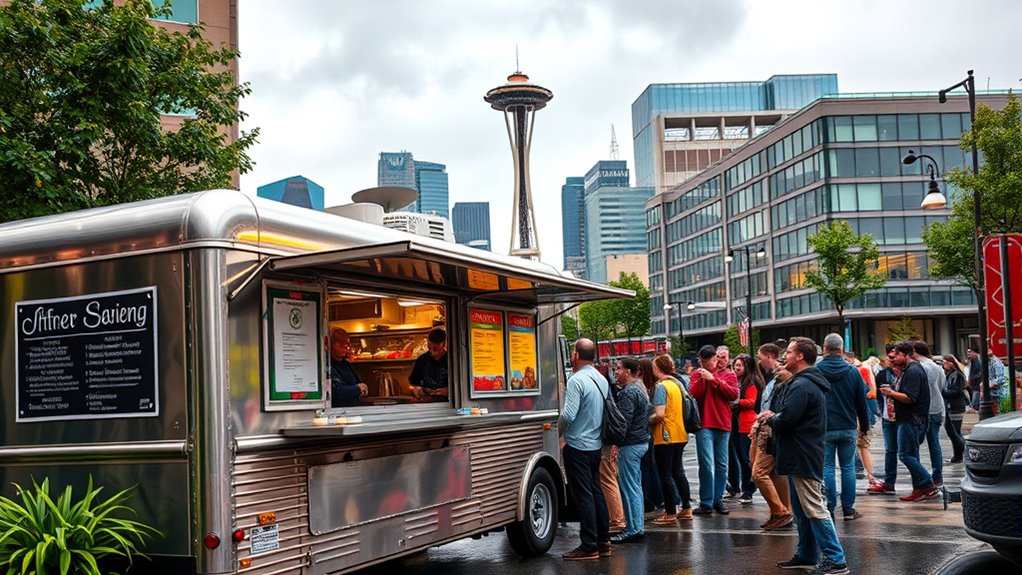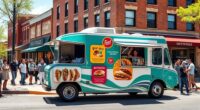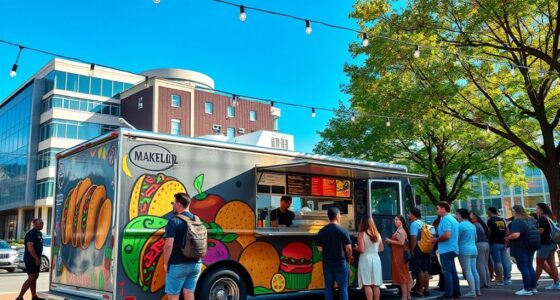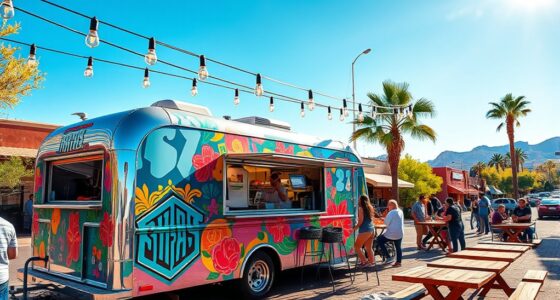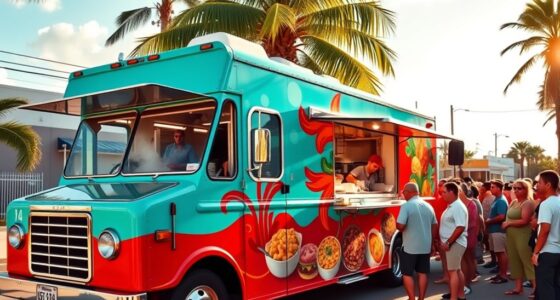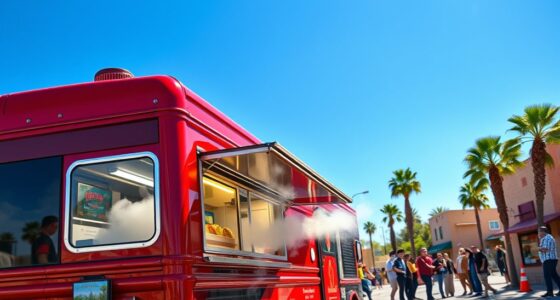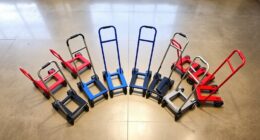To start a food truck in Seattle, WA, you need to secure permits from the Seattle Department of Finance and Administrative Services, register your vehicle, and get the necessary health and business licenses. Make sure to meet sanitation standards, adhere to parking and zone regulations, and get insurance coverage. Developing a strong local network and engaging with community events will boost your visibility. Keep exploring the full process for tips and strategies to set your business up for success.
Key Takeaways
- Obtain necessary permits and licenses through Seattle’s Department of Finance and Administrative Services.
- Secure proper insurance coverage, including liability insurance, to protect your business.
- Develop a menu using local ingredients, sourcing from regional farmers and highlighting Seattle-specific foods.
- Engage with the community and utilize social media to build brand awareness and attract customers.
- Budget for startup costs, apply for small business grants, and implement cost-effective inventory and payment systems.
Starting With a Food Truck License
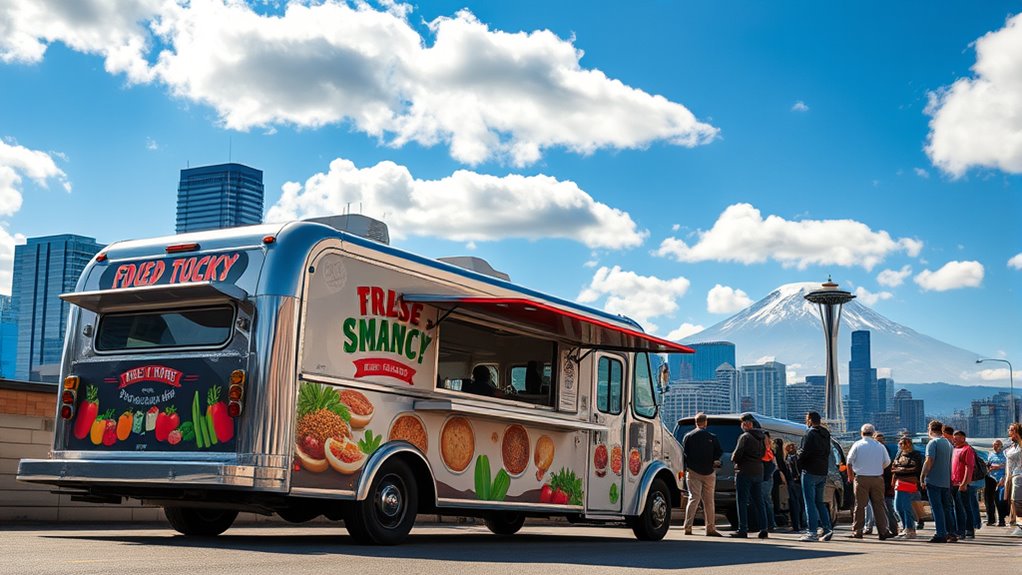
Getting a food truck license is the essential first step before you hit the streets of Seattle. To start, you need to secure the necessary food truck permits, which guarantee your vehicle and operations comply with local health and safety standards. This process involves applying through the Seattle Department of Finance and Administrative Services. Additionally, you’ll need to handle vehicle registration to legally operate your truck on city streets. Proper registration confirms your vehicle meets state and local regulations, preventing potential fines or shutdowns. Make sure your truck has the appropriate insurance coverage as well. Once you’ve obtained the food truck permits and completed vehicle registration, you’ll be ready to move forward with other licensing requirements and officially launch your food truck business in Seattle. For added convenience, consider portable power sources to keep your equipment running smoothly during busy hours.
Understanding Local Requirements
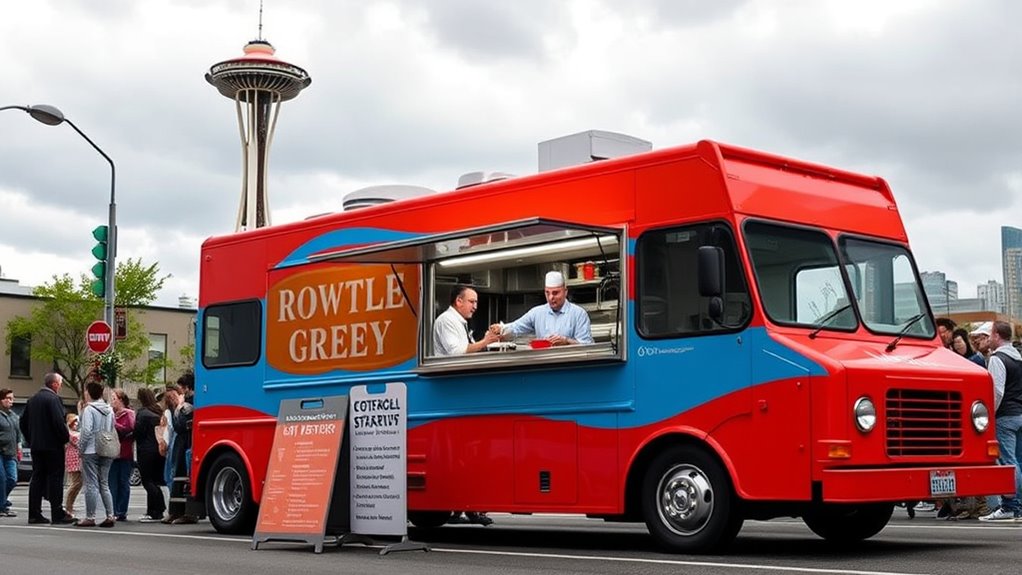
To operate a food truck in Seattle, you need to understand the local requirements thoroughly. This includes completing the business license application, adhering to sanitation protocols, and obtaining the necessary documentation. You’ll also need to know the designated food truck zones where you’re allowed to park and serve. Additionally, implementing organizational strategies can help you efficiently manage your space and supplies on the truck.
Seattle Business License Application Process
Securing a business license in Seattle involves understanding and fulfilling specific local requirements. First, you’ll need to apply through the Seattle Business Licensing Service. Be prepared to provide details about your food truck, including your food truck branding and menu. Next, make sure you submit the necessary documentation, such as proof of identity and location permits. Here’s what to keep in mind:
- Complete the online application accurately.
- Pay the applicable licensing fees.
- Obtain any additional permits, like health or parking permits.
- Register your business with the city for tax purposes.
Once licensed, leverage social media promotion to build your brand awareness. A strong online presence complements your licensing efforts and helps attract customers to your food truck.
Sanitation Protocols and Documentation
Understanding local sanitation protocols is essential for operating your food truck legally and ensuring customer safety. You must adhere to specific food safety standards and prepare for regular health inspections. Proper documentation, such as cleaning logs and temperature records, demonstrates your commitment to cleanliness. Visualize these requirements like this:
| Cleaning Schedule | Temperature Logs | Inspection Reports |
|---|---|---|
| Daily cleaning of surfaces | Record fridge/freezer temps | Maintain reports from health checks |
| Sanitizing utensils | Check cooking temps | Keep inspection notices visible |
| Waste disposal | Monitor holding temps | Track corrective actions |
These records prove your adherence during health inspections, helping you pass with flying colors and keep your customers safe. Staying organized ensures compliance and peace of mind.
Designated Food Truck Zones
Knowing where you can legally park and operate your food truck is essential for staying compliant with local regulations. In Seattle, designated food truck zones help ensure you meet parking regulations and obtain the proper food truck permits. To navigate these zones effectively, keep in mind:
- Always verify zone-specific rules before parking.
- Obtain necessary permits for each designated area.
- Follow time restrictions for parking duration.
- Respect no-parking or restricted zones to avoid fines.
Understanding these local requirements will save you time and money. By focusing on designated zones, you reduce the risk of violations and ensure your business runs smoothly. Staying informed about parking regulations and securing the right permits guarantees you operate legally and build a good reputation in Seattle’s vibrant food scene.
Setting Up Your Base of Operations

Setting up your base of operations involves choosing the right space to prepare your food and manage your business. Shared kitchen licensing options can save you money and simplify compliance, while custom kitchen layouts help optimize space and workflow. Consider these points carefully to guarantee your setup supports your food truck’s success. Additionally, understanding the types of cookies used on your website can help you manage privacy preferences and improve your overall experience.
Shared Kitchen Licensing Options
If you’re looking to launch your food truck without the high costs of a dedicated commercial kitchen, sharing a licensed kitchen space can be an excellent option. Shared kitchens offer flexible licensing options, making it easier to start operating quickly. When choosing a shared kitchen, consider these key points:
- Verify the shared kitchen’s licensing and health department compliance.
- Ensure the space meets your specific food prep needs.
- Confirm the availability of necessary permits for your menu.
- Check if the shared kitchen provides storage and equipment support.
Using shared kitchen licensing options can notably reduce startup costs and streamline your launch process. Plus, it offers a legal, compliant base of operations, so you can focus on perfecting your menu and building your brand in Seattle.
Custom Kitchen Layout Planning
Designing a custom kitchen layout is a essential step in establishing an efficient and functional food truck operation. Focus on optimizing kitchen ergonomics to guarantee you can work comfortably and safely, reducing fatigue and increasing speed. Carefully plan your layout to maximize layout efficiency, placing frequently used equipment within easy reach and minimizing movement. Consider the flow of ingredients, tools, and waste to streamline your cooking process. Use compact storage solutions to keep your workspace organized and clutter-free. Prioritize safety by guaranteeing proper ventilation, fire suppression, and clear pathways. A well-designed kitchen layout not only boosts productivity but also helps you deliver quality service quickly, which is indispensable in the fast-paced food truck industry.
Budgeting and Financing Your Food Truck
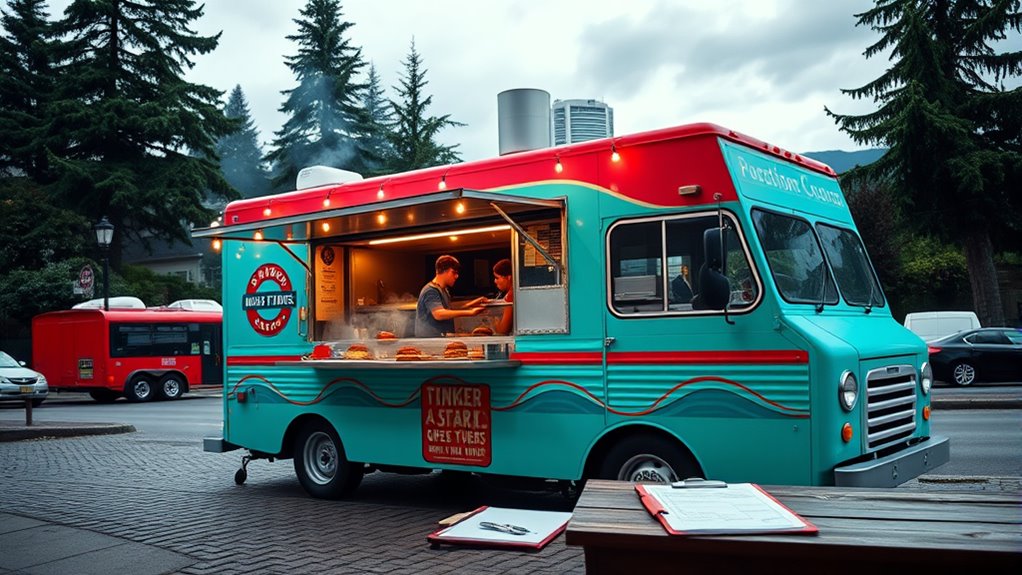
Understanding your startup costs is vital, especially when it comes to equipment expenses like trucks, kitchen gear, and signage. You should also explore local small business grants that can help ease your financial burden. Additionally, securing liability coverage is essential to protect your business and meet Seattle’s insurance requirements. Be aware that navigating regulatory compliance can be complex, so consulting with legal experts or industry associations may prove beneficial.
Initial Equipment Investment Breakdown
Budgeting for your food truck’s initial equipment involves carefully estimating costs for essential items like cooking appliances, refrigeration units, serving counters, and safety gear. Proper budgeting guarantees you cover all necessary expenses without overspending. Focus on these key areas:
- Cooking appliances and prep stations to handle menu demands
- Refrigeration units for food safety and storage
- Serving counters and point-of-sale systems for customer interaction
- Safety gear, including fire suppression and sanitation equipment
Local Small Business Grants
Are you aware that local small business grants can considerably reduce the financial burden of starting your food truck? These grants are a great way to access funding without the need for repayment or increasing debt. In Seattle, several programs support small businesses, including food truck startups, through local small business grants. Applying for these grants can improve your food truck financing options, making it easier to cover costs like permits, equipment, and initial inventory. Keep an eye on city and state resources, as they often have grants specifically for entrepreneurs in the food industry. Securing a grant not only eases your financial load but also adds credibility to your venture, helping you attract additional funding or investors as you grow your food truck business in Seattle.
Liability Coverage for Food Trucks
Securing adequate liability coverage is a crucial step in budgeting and financing your food truck, as it helps protect your business from costly legal claims and damages. Food truck liability is essential because accidents can happen anywhere—whether it’s a customer slipping or property damage. To guarantee proper protection, consider these key points:
- Choose extensive liability insurance that covers bodily injury and property damage.
- Verify coverage limits align with your business size and risks.
- Understand exclusions to avoid gaps in protection.
- Regularly review and update your policy as your food truck expands.
Having the right liability coverage not only safeguards your investment but also boosts customer confidence, making it easier to operate and grow your food truck business in Seattle.
Designing Your Menu and Pricing Strategy
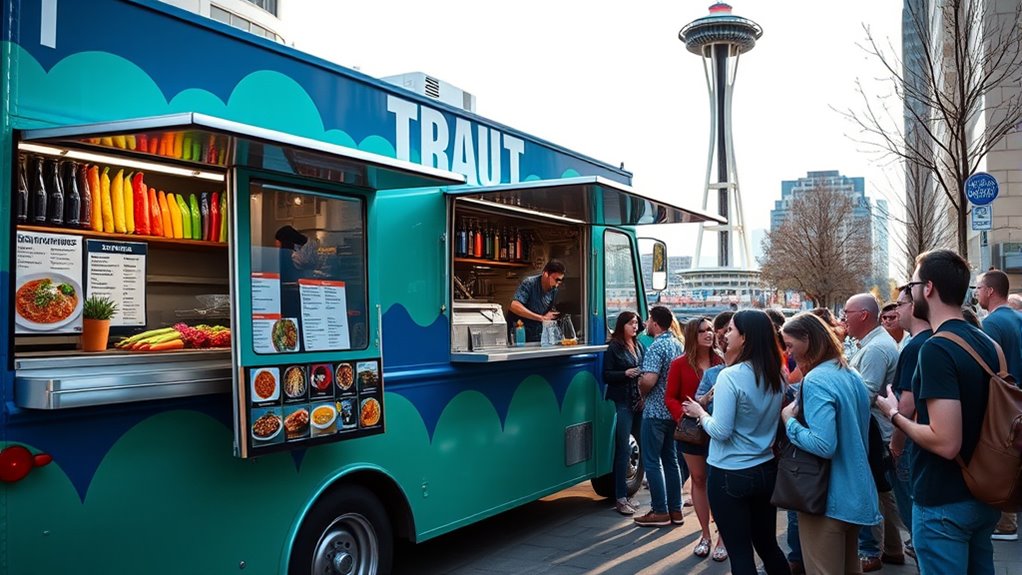
When designing your menu, focus on sourcing innovative local ingredients that set your offerings apart. Keep your pricing strategy aligned with ingredient costs to guarantee profitability without turning customers away. Balancing quality and affordability will help you attract and retain a loyal customer base in Seattle. Additionally, considering aesthetic modifications can enhance your food truck’s visual appeal and draw in more customers.
Innovative Local Ingredient Sourcing
Leveraging innovative local ingredients can set your food truck apart and create a unique menu that resonates with the Seattle community. By prioritizing local ingredient sourcing, you demonstrate your commitment to sustainability and support for regional farmers. Here are four ways to incorporate this approach:
- Build relationships with local growers to access fresh, seasonal produce.
- Use sustainable food practices to reduce waste and minimize environmental impact.
- Feature ingredients unique to Seattle, like Duwamish River fish or Hood Canal shellfish.
- Highlight your sourcing story on your menu to appeal to eco-conscious customers.
Focusing on local ingredient sourcing not only improves flavor quality but also aligns your brand with Seattle’s values, fostering loyalty and community support.
Optimal Pricing Based on Ingredient Costs
After establishing strong relationships with local growers and highlighting your sourcing story, it’s important to set menu prices that reflect your ingredient costs while remaining attractive to customers. Conduct thorough ingredient cost analysis to understand the true expense of each dish. This helps you develop effective menu pricing strategies that balance profitability with affordability. Consider all costs, including procurement, preparation, and overhead, to determine a sustainable price point. Use this data to create a menu that highlights your best ingredients without overpricing. Regularly review your ingredient costs and adjust prices as needed to stay profitable. By keeping your pricing strategy aligned with ingredient costs, you ensure your food truck remains competitive and financially healthy while offering quality meals to your customers.
Technology and Operations

You can make transactions faster and safer by offering contactless payment options. Using a mobile POS system helps you manage sales smoothly and stay organized. Keeping track of stock with digital tools guarantees you never run out of ingredients during busy hours.
Contactless Payment Options Available
Many food trucks in Seattle now offer contactless payment options, making transactions faster and more convenient for customers. Using contactless payments, you can reduce wait times and streamline operations. Mobile ordering features also allow customers to place orders ahead, ensuring quicker service. To get started, consider these key benefits:
- Faster checkout times, improving customer satisfaction
- Reduced cash handling, enhancing safety and hygiene
- Seamless integration with POS systems for efficient sales tracking
- Increased sales opportunities through easy mobile ordering options
Implementing contactless payments can boost your efficiency and appeal to tech-savvy customers. By embracing these modern payment methods, you’ll stay competitive and meet the evolving expectations of Seattle’s vibrant food scene.
Mobile POS and Stock Tracking
Integrating mobile POS systems and stock tracking tools can substantially streamline your food truck’s operations by providing real-time sales data and inventory updates. With a mobile POS, you can process orders quickly, reduce errors, and improve customer service. Stock tracking tools help you monitor inventory levels accurately, preventing shortages and overstocking. These technologies enable you to analyze sales trends and adjust your menu or inventory accordingly. The seamless connection between your mobile POS and stock tracking system guarantees you stay informed and make smarter decisions on the go. This setup minimizes manual effort, saves time, and increases efficiency, allowing you to focus more on delivering quality food and a great customer experience. Ultimately, tech-driven operations help your food truck run smoothly and profitably.
Marketing and Growing Your Presence
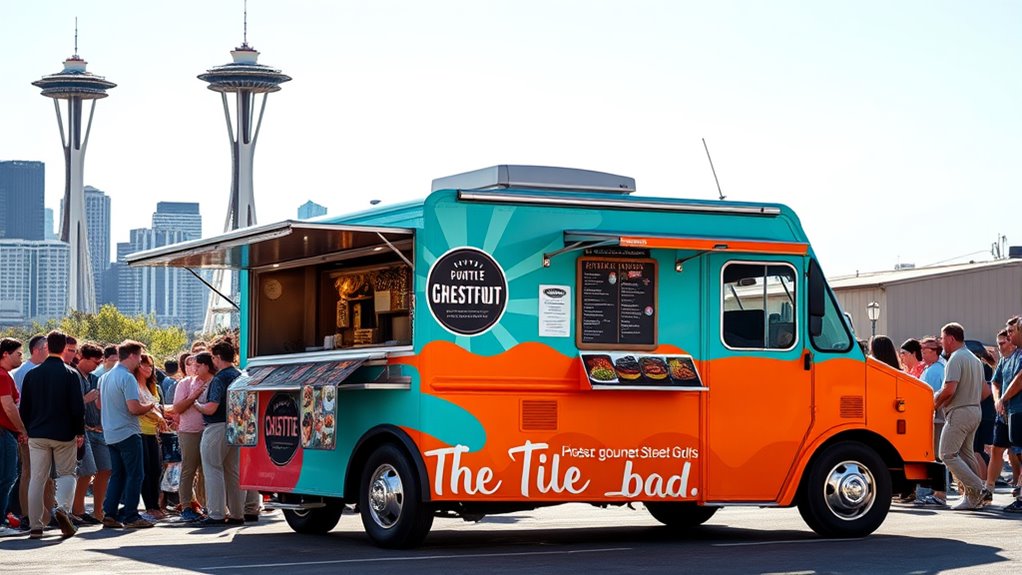
Participating in popular food truck festivals can give you instant visibility and connect you with new customers. Engaging with the vibrant Instagram foodie community helps showcase your dishes and builds loyal followers. Both strategies are key to expanding your presence and attracting more fans to your truck.
Popular Food Truck Festivals
Have you ever wondered how food trucks build their popularity across Seattle? Attending popular food truck festivals is a smart move. These events boost your food truck branding and help you connect with new customers. To maximize your presence, focus on these key strategies:
- Register early and choose festivals with high foot traffic.
- Use social media marketing to announce your participation and generate buzz.
- Offer exclusive festival-only specials to attract repeat visitors.
- Engage with attendees and gather feedback to improve your offerings.
Participating in festivals not only increases visibility but also creates loyal fans who will follow your journey. Use these opportunities to showcase your unique cuisine and strengthen your brand in the local food scene.
Engaging Instagram Foodie Community
If you want to stand out on Instagram, engaging with the foodie community is essential. Active Instagram engagement helps you build relationships, gain followers, and showcase your food truck’s unique offerings. To connect effectively, comment on posts, share user-generated content, and use relevant hashtags. This fosters a sense of community and encourages others to engage with your content. Visuals matter—share vibrant photos of your dishes, behind-the-scenes shots, and customer moments. Here’s a snapshot of how your engagement might look:
| Post Type | Goal | Example |
|---|---|---|
| Customer Photos | Build community | Repost a happy customer’s pic |
| Behind-the-Scenes | Personalize your brand | Prep process or truck setup |
| Food Highlights | Showcase menu items | Close-up of signature dish |
Consistent effort boosts your presence and turns followers into loyal fans.
Navigating Seattle’s Food Scene

Exploring Seattle’s vibrant food scene can be both exciting and overwhelming, especially with the city’s diverse culinary options spread across neighborhoods. To navigate effectively, focus on local hotspots that showcase street art and foster community engagement. These areas often highlight the city’s culture and provide authentic experiences. Consider these tips:
- Follow food festivals and markets to discover new vendors.
- Visit neighborhoods known for street art, like Capitol Hill or Fremont.
- Engage with locals to get insider tips on hidden gems.
- Attend community events that celebrate local cuisine and art.
Frequently Asked Questions
What Are the Best Locations to Park a Food Truck in Seattle?
You should target busy areas like South Lake Union and Pike Place Market, where high foot traffic guarantees more customers. Before parking, get the necessary parking permits from the city to avoid fines. Conduct a foot traffic analysis to identify peak times and ideal spots. Parking during these peak hours can boost your sales, so plan your location and schedule accordingly to maximize your food truck’s success in Seattle.
How Do I Find Reliable Vendors for Food Truck Supplies?
You find reliable vendors for food truck supplies by researching vendors with strong reputations for vendor reliability and consistent quality. Use online reviews, industry forums, and local business networks to identify trusted suppliers. Build relationships with vendors who prioritize your supply chain needs, ensuring timely deliveries and quality products. Don’t hesitate to ask for references or samples to verify their reliability before committing long-term, ensuring your food truck runs smoothly.
Are There Specific Seattle Health Regulations for Food Truck Waste Disposal?
Think of Seattle’s health regulations for waste disposal like a carefully guarded treasure map. You must separate grease from water, use approved containers, and follow strict disposal procedures. These rules ensure your waste disposal doesn’t pollute the environment or violate local laws. Always check with the Seattle Department of Health for current guidelines, because staying compliant maintains your food truck running smoothly and avoids costly fines or shutdowns.
What Permits Are Needed for Special Events or Festivals?
For special events or festivals, you need specific food truck permits and festival licensing from Seattle authorities. You should apply for a temporary food service permit, which covers your food truck at these events, and verify your regular food truck permits are up-to-date. Contact the Seattle Department of Health and the event organizers early to confirm requirements, as regulations vary by event. This proactive approach helps you avoid delays and ensures smooth participation.
How Can I Build Relationships With Local Seattle Food Communities?
Think of building relationships with Seattle’s food community like planting a garden—you need consistent care and connection. You can start by attending local food events, joining community forums, and collaborating with other vendors. Use social media outreach to showcase your story and engage with local chefs and foodies. Sharing your experiences and supporting others fosters trust, strengthening your ties and helping your food truck thrive in Seattle’s vibrant scene.
Conclusion
Starting your food truck journey in Seattle can be challenging, but remember, “A journey of a thousand miles begins with a single step.” Stay informed about local regulations, craft a unique menu, and connect with your community. With passion and persistence, you’ll turn your food truck into a beloved local fixture. Keep your eyes on the prize, and soon, you’ll be serving up success on every corner of Seattle’s vibrant food scene.
